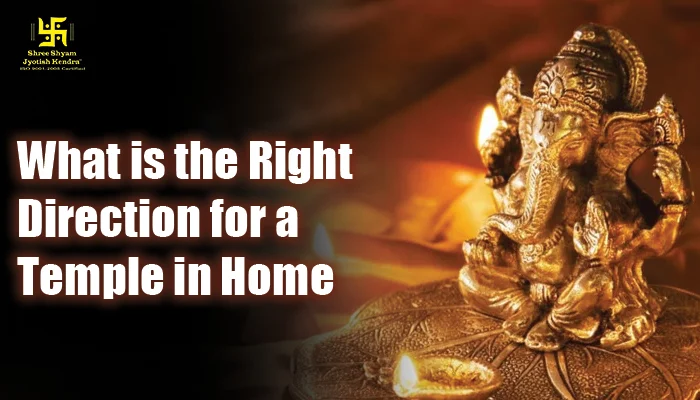 Placing your temple in the right direction isn’t just about tradition; it’s about tuning your home with the flow of energy that invites peace, purpose, and prosperity.
Placing your temple in the right direction isn’t just about tradition; it’s about tuning your home with the flow of energy that invites peace, purpose, and prosperity.
As shared by the best Vastu Consultant in India, even the smallest alignment in your living space can shape the way energy flows into your life.
Walk into any peaceful home, and you’ll find something sacred. Often, it’s a small corner lit with a diya, carrying the aroma of incense, and filled with devotion. That spiritual space; the home temple is more than just a corner for prayer. It’s a gateway for divine energy.
But here’s something few homeowners know: If your temple isn’t placed in the correct direction, it may disturb the very harmony you’re trying to invite.
Let’s explore what Vastu Shastra truly says about where your temple should go and why the direction matters more than most people think.
Why Direction Matters for Your Home Temple
In Vastu, every direction carries a specific energy vibration. These energies are not symbolic—they’re functional. Just as the sun rises from the East and brings light, certain directions in your home naturally support specific activities.A temple placed correctly aligns your home with:
- Calm and spiritual balance
- Mental clarity
- Harmonious family relationships
- Financial growth
- Overall well-being
Best Direction for Temple in Home as Per Vastu
Northeast: The Ideal DirectionIf there’s one direction that Vastu considers sacred beyond doubt, it’s the Northeast, or what’s known as Ishan Kon.
This space is ruled by divine energies and supported by the planets Jupiter and Shiva. It is said to be the zone of enlightenment, knowledge, and purity.
Why choose Northeast?
- It’s the most spiritually charged corner of your home
- Allows natural sunlight during early hours, amplifying positivity
- Promotes peaceful thoughts and sharper concentration
- Helps in deepening your spiritual connection
East: A Powerful Alternative
In case the Northeast isn’t available, East is your next best option. It’s the direction from where the sun rises, symbolizing new beginnings, wisdom, and inner awakening.
Why it works:
- Brings clarity and vitality
- Supports consistent spiritual practice
- Energizes the home during early morning rituals
North: The Direction of Growth
North is associated with Lord Kuber, the deity of wealth and prosperity. For those looking to invite abundance and stability into their lives, this direction offers a strong energetic advantage.
North is ideal if you:
- Run a business from home
- Want to improve your finances
- Seek long-term security in career and personal growth
Also Checkout our thoughts on Which Direction to Sleep As Per Vastu?

Directions to Avoid for Placing Temple in Home
Knowing where not to place your temple is just as important as knowing the right spot.South
This direction is governed by Yama, the god of death. While the South can be stabilizing in some Vastu contexts, it is not suitable for prayer or spiritual focus.
Southwest
Often called the Pitru Sthaan, or zone for ancestral energies, the Southwest corner is more suitable for family stability—not for spiritual activities. A temple here may lead to unnecessary conflicts and stress.
Under Staircases or Beside Bathrooms
Never place a temple below a staircase or next to a washroom. This placement disrupts energy flow and is considered highly inauspicious. It also disrespects the sanctity of the space.
Common Vastu Mistakes in Temple Placement
Avoiding these small but significant mistakes can preserve the purity and strength of your spiritual zone:- Don’t keep broken or chipped idols. Even the smallest crack is seen as energy leakage.
- Never use the temple area for storing household items. Keep it clutter-free and serene.
- Avoid placing photos of deceased family members in the temple. This space is meant for divine energies, not ancestral remembrance.
- Keep the temple higher than floor level. A platform or base is essential.
- Always light a lamp daily. Even a single diya in the evening uplifts the atmosphere significantly.
Need Personalized Guidance for Your Home?
When it comes to aligning energy, there is no one-size-fits-all. A consultation can help identify not only the right direction for your temple, but also the corrections your space might need to invite better fortune.Get expert Vastu and Astrology insights directly from Pt. Pawan Kaushik, the No.1 Vastu Consultant in Delhi.
To schedule a personal session, contact now through the official website or phone. Transform your space, transform your life.
Also Checkout our thoughts on What Are The Vastu Dosha Based On Directions & How To Rectify Them

Conclusion
Your temple is not just a part of your home; it’s the heart of it. Its direction, placement, and energy can silently influence how you think, feel, and live.Let it be a space that uplifts you, grounds you, and connects you to something bigger.
Because when your environment aligns with the divine, everything else begins to flow.
If you’re unsure about where your temple should go, or you suspect the energy in your home feels a bit off, don’t leave it to guesswork.
Ready to Channel Divine Energy into Your Home?
Consult Pt. Pawan Kaushik, the most famous Vastu expert in India, and experiences the power of Vastu aligned with your personal astrological blueprint. Book your consultation today to harmonize your property space.
 +91 9990176000
+91 9990176000 +91 9999097600
+91 9999097600
 CALENDAR 2025
CALENDAR 2025











